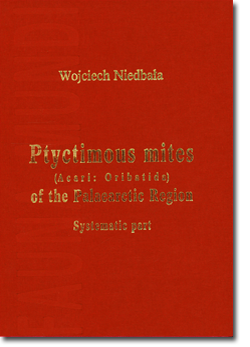 |
Wojciech Niedbała Warsaw 2011 165 x 235 mm, hardcover, 472 pages, 189 figures plates ISBN 978-83-930773-2-8, ISSN 2081-4615 Publisher:
|
Abstract
On the basis of morphological features a systematic analysis was made of 293 species and two subspecies from the Palaearctic region, belonging to following groups of ptyctimous mites: Protoplophoridae – 15 species, Archoplophoridae – one species, Mesoplophoridae – five species, Apoplophoridae – three species, Euphthiracaroidea – 93 species and two subspecies and Phthiracaroidea – 176 species. For each species a diagnosis was given accompanied by a differentiating analysis between the closest related species.
For five genera and subgenera stat. nov. was proposed, 15 species and five subspecies were treated as syn. nov.; 12 type species and one subspecies were redescribed on the basis of type material.
A chorotype, i.e. geographical range of each species was established.
Keys for identification of cohorts, families, genera, subgenera and species were prepared. As many as 35 species were classified as species inquirendae.
Twenty six species originating from other zoogeographical regions have been introduced to Palaearctic in Prooriental and East-Asiatic parts. The number of wide-distributed species was found to be rather high – 45, including semicosmopolitan, Holarctic and Panpalaearctic ones. Eight species were established to be somewhat less wide-distributed in some parts of the Palaearctic. Over two thirds of the total number of species, that is 215 species were proved to be relatively narrowly distributed and 115 of them were endemic.
Keywords
Acari, Oribatida, Ptyctima, Palaearctic, systematic









